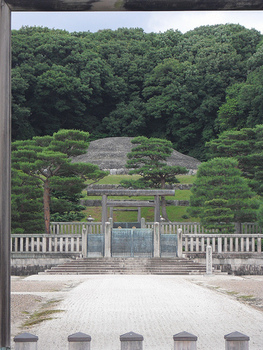Difference between revisions of "Emperor Meiji"
| Line 33: | Line 33: | ||
[[Category:Meiji Period]] | [[Category:Meiji Period]] | ||
| − | [[Category:Emperors]] | + | [[Category:Emperors|Meiji]] |
Revision as of 13:59, 16 April 2013
The Meiji Emperor was the great-grandfather of the current Emperor of Japan. Following the fall of the Tokugawa shogunate in 1868, he was the first Emperor since Emperor Kemmu in the 1330s to rule the country in the absence of a shogunate; he was also the last Emperor to reign in Kyoto.
Life & Reign
Emperor Meiji, known by his personal name Mutsuhito during his life, was the son of Emperor Kômei and Nakayama Yoshiko, an imperial concubine. His wife, Ichijô Haruko, came to be known as Empress Dowager Shôken.
Meiji took the throne on 1867/1/9, less than a year before Tokugawa Yoshinobu stepped down as Shogun, marking the end of the Tokugawa shogunate, and the "restoration" of Imperial rule.
His reign, known as the Meiji period (1867-1912), was marked by dramatic, rapid modernization and Westernization, as the country industrialized, militarized, began colonial/imperial expansion, instituted a system of rule based around a constitutional/parliamentary monarchy, nationwide public education, and a myriad of other reforms and developments.
Emperor Meiji died in 1912, and was succeeded by his son, the Taishô Emperor. He was entombed at the former site of Fushimi castle, a short distance from the grave of Emperor Kammu; thus, the first and last emperors to reign in Heian-kyô (Kyoto) are buried nearby one another.
| Preceded by Emperor Kômei |
Emperor of Japan 1867-1912 |
Succeeded by Emperor Taishô |
References
- "Chronology of the Japanese Emperors since the Mid-Nineteenth Century." in Handbook of Oriental Studies. Boston: Brill Academic Publishers, 2008. pp335-336.

